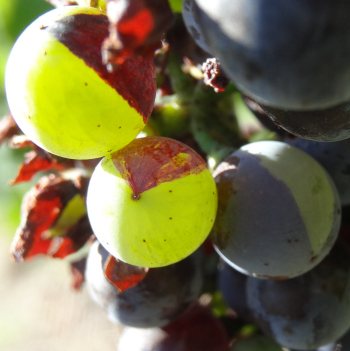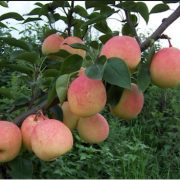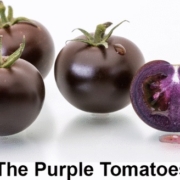Variegated grape berries enlighten us about plant radiation responses
Zhang et al. identify a regulatory hub in grapevine controlling divergent specialized metabolic pathways as part of the light/UV radiation response.
Plant Cell. https://doi.org/10.1093/plcell/koad228
By José Tomás Matus and Chen Zhang
Institute for Integrative Systems Biology (I2SysBio), Universitat de València-CSIC, 46980 Paterna, Valencia, Spain.
Background: Since plants made the move to land, they have had to adapt to exposure to high-intensity light and ultraviolet radiation. Anthocyanins that accumulate in epidermal cells shield plant tissues from radiation; the absence of these red/purple pigments negatively affects photosynthesis and other physiological processes. We identified and compared pigmented and unpigmented sections of rare, variegated grapevine (Vitis vinifera) berries to see whether different light responses were occurring in red and white skin sections.
Question: What are the causes and effects of berry color variegation? Does a central genetic switch contribute to the abundance of phenylpropanoids and isoprenoids in variegated berries? Can we integrate computational analyses and experimental evidence to disentangle these questions?
 Findings: White variegation in red-skinned grapevine fruits is caused by the presence of non-functional alleles of MYBA1/A2 transcription factors that naturally control anthocyanin biosynthesis. The absence of these pigments enhances a ripening-dependent regulatory network mediated by MYB24 that promotes protection against ultraviolet and high-light intensity stress. In response, white skin sections accumulate higher levels of antioxidant monoterpenes and UV-shielding flavonols; however, these compounds only partially ameliorate the detrimental effects of excessive radiation. Genes related to carotenoid metabolism, photosynthesis and other light signaling responses are bound and directly regulated by MYB24. By conducting in silico and in vitro analyses and using field-grown grapevine plants, we demonstrate that MYB24 orchestrates different specialized metabolism pathways in berry skins in response to increased levels of radiation caused by pigment depletion.
Findings: White variegation in red-skinned grapevine fruits is caused by the presence of non-functional alleles of MYBA1/A2 transcription factors that naturally control anthocyanin biosynthesis. The absence of these pigments enhances a ripening-dependent regulatory network mediated by MYB24 that promotes protection against ultraviolet and high-light intensity stress. In response, white skin sections accumulate higher levels of antioxidant monoterpenes and UV-shielding flavonols; however, these compounds only partially ameliorate the detrimental effects of excessive radiation. Genes related to carotenoid metabolism, photosynthesis and other light signaling responses are bound and directly regulated by MYB24. By conducting in silico and in vitro analyses and using field-grown grapevine plants, we demonstrate that MYB24 orchestrates different specialized metabolism pathways in berry skins in response to increased levels of radiation caused by pigment depletion.
Next steps: Future research should be oriented towards identifying the regulators of MYB24 in order to determine the full regulatory network of MYB24-controlling light responses and late fruit-ripening processes.
Reference:
Chen Zhang, Zhanwu Dai, Thilia Ferrier, Luis Orduña, Antonio Santiago, Arnau Peris, Darren C. J. Wong, Christian Kappel, Stefania Savoi, Rodrigo Loyola, Alessandra Amato, Bartosz Kozak, Miaomiao Li, Akun Liang, David Carrasco, Carlos Meyer-Regueiro, Carmen Espinoza, Ghislaine Hilbert, Rosa Figueroa-Balderas, Dario Cantu, Rosa Arroyo-Garcia, Patricio Arce-Johnson, Patricia Claudel, Daniel Errandonea, Manuel Rodríguez-Concepción, Eric Duchêne, Shao-shan Carol Huang, Simone Diego Castellarin, Giovanni Battista Tornielli, Francois Barrieu, José Tomás Matus (2023). MYB24 orchestrates terpene and flavonol metabolism as light responses to anthocyanin depletion in variegated grape berries. https://doi.org/10.1093/plcell/koad228







